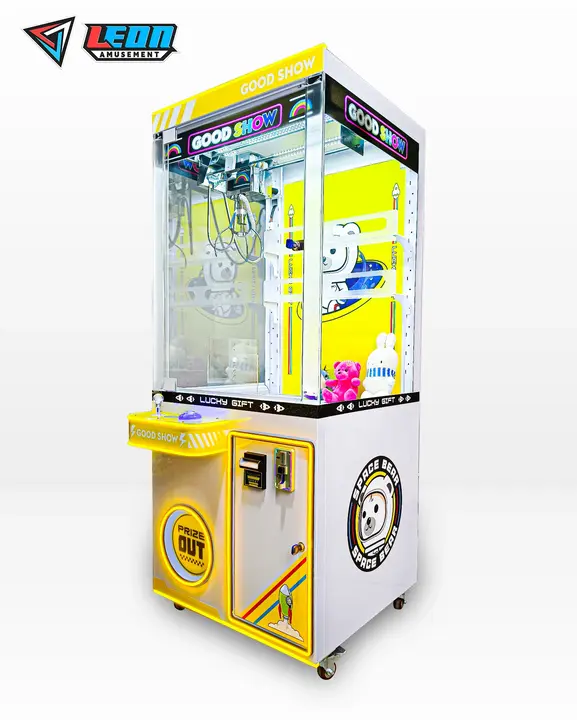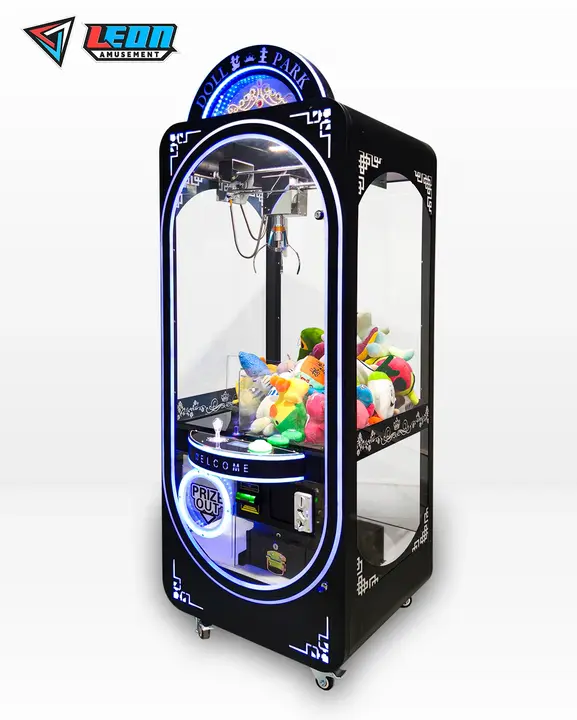The claw machine comprises a cabinet, crane assembly, control mechanism, prize area, and sophisticated electronics that manage gameplay and functionality.
Table of Contents
ToggleThe Cabinet
Structure and Materials
The construction of a claw machine defines both its outward appearance and ensures its strength and security over time. Commonly built from tempered glass or heavy-duty acrylic, these durable materials are chosen to withstand heavy usage while allowing clear visibility of the prizes within. A sturdy frame of metal or long-lasting plastic supports and encloses the entire mechanism, protecting it from potential tampering.
Design and Personalization
More than function, the visual flair of a claw machine draws players in. Manufacturers frequently customize exteriors with bright hues, flashing lights, and brand-themed graphics to attract attention. Nearby theaters, for instance, may display movie posters or character cutouts related to new releases showing, enhancing relevance and visual interest for patrons.
Accessibility and Fortification
The front panels utilize see-through glass, usually tempered for break-resistance, permitting observation of the reward stash within. Security measures on the casing are rigorous, involving high-security locking to bar unauthorized entry while allowing convenient restocking and servicing by operators.
Ergonomics and Engagement
Comfort is key in cabinet layout. Placing controls at heights for both children and adults optimizes involvement. Button and joystick interfaces are also engineered for longevity and tactility under heavy play.
Integration of Advancements
Modern claw games merge sophisticated technologies internally. Digital displays provide gameplay information or scoreboards, occasionally merging with touchscreen menus for more interactivity. Such features elevate the fun while yielding usage data that aids in strategizing modifications or maintenance scheduling.

The Crane Assembly
Mechanical Components
A claw machine’s complex crane assembly is a critical part of its functionality and consists primarily of a gripper, a manipulator arm, and a precision motor. The rugged metal claw is designed for durable object manipulation and precise positioning of the target. A connecting arm enables movement up, down, left, and right. This motion is derived from one or more commonly used stepper motors, which are known for their tiny incremental adjustments within a hundredth of a millimeter, allowing the claw to be precisely positioned over the coveted prize.
Electrical System
The electrical mechanism that powers the crane assembly includes wiring, control circuitry, and a power supply. The circuitry interprets user inputs on the control interface, translating selections into crane displacements. The system is designed for complex, continuous motion while remaining responsive to player manipulation. Wiring quality and control board responsiveness are critical to maintaining a smooth and enjoyable gaming experience.
Design for Reliability
Manufacturers focus on the durability and reliability of the crane assembly because they know these machines will be used frequently. Components are tested to withstand thousands of operations without failure. For example, the average claw machine can withstand approximately 10,000 games before the crane assembly requires maintenance. This robustness stems from the use of high-grade metals and a solid mechanical structure.
Safety Features
Safety is a key aspect of the crane assembly’s formation. Features such as automatic cut-off prevent the crane from going beyond its defined area, protecting both the equipment and the players. In addition, the assembly contains sensors that detect and respond to obstacles or anomalies that could jeopardize functionality.
Integration with Software
The mechanized movement of the crane assembly is controlled by computation and driven mechanically. This programming confirms that the crane operation complies with the rules of the game and oversees aspects such as game time, claw strength, and probability of winning. Operators can modify the software to ensure compliance with local gaming regulations and provide players with a fair chance of success.
Control Mechanism
Input Devices
The primary interface for interacting with claw machines varies depending on their design and consists of elements such as joysticks, buttons, and touchscreens. Joysticks enable the claw to flexibly move from left to right or forward and backward on the play field. Buttons initiate key actions, such as lowering the claw or activating a bonus feature. Today’s models often feature touch-responsive displays, allowing intuitive gestures to mimic joystick control. Manufacturers ensure reliable operation by using rugged components that can withstand endless play without failure.
Electronic Control Units
At the heart of a claw machine is the electronic control unit (ECU), a digital brain that translates user input into precise claw movements. By running specialized embedded software, the ECU can expertly process joystick, button, or touch input to flexibly manipulate the claw assembly in real time. Settings within the ECU can calibrate factors such as claw strength and speed, allowing operators to customize difficulty. In addition, ECU diagnostics assist technicians with routine inspections and troubleshooting through accessible menus.
Copper Wires and Secure Connections
In claw machines, reliable circuits are critical. Copper wires transmit electrical signals and require strong conductivity and minimal susceptibility to failure. All connections are thoroughly soldered and extra-covered to prevent wear and tear that can cause intermittent failures or downtime. With reliable circuitry, claw machines can withstand endless hours of intense play without interruption.
Information Display
Modern claw machines often feature brightly colored digital displays and LED panels above the controller. These interfaces provide players with helpful timers, point counts, or success feedback. Additionally, interactive touchscreens can provide game tutorials or promotional content, which enhances engagement. These features generate supplemental marketing value while enhancing the entertainment experience to drive revenue.
Modular Components
For technicians, claw machine design prioritizes easy service access. Components are modular in construction to facilitate quick replacement or upgrades. Control panels provide diagnostic access for easy regular inspection and troubleshooting, minimizing downtime. This serviceability is critical to maintaining high availability – a necessity for maximizing profits from these entertaining arcade facilities.

Prize Area
Design and Appearance
The prize compartments of claw machines are carefully designed to enhance visuals and stimulate the gaming experience. Typically, the area has soft padding to protect the prizes and reduce noise when the items are stored. The organization is usually layered or segmented, allowing for clear display of prizes of different sizes. Operators can adjust the depth and partitions according to the type of merchandise on offer, ensuring that everything is achievable and attractively displayed.
Brightness and Visibility
Professional lighting of the prize area is essential to highlight the prizes and make them irresistible to players. LED lighting is widely used due to its long life and energy efficiency. The lighting is arranged to eliminate shadows and illuminate the prizes evenly from all angles, which not only enhances their color and details, but also increases the inferred value of the items.
Accessibility and Security
The prize area has a secure access point, usually located on the side or back of the machine, allowing administrators to easily replenish prizes without compromising the security of the machine. This entrance usually has a strong locking system to prevent authorized access. The administrator has a key that can open other machines, which simplifies management and improves security protocols.
Prize Selection and Placement
Determining the appropriate prize mix is a matter that can have a significant impact on a machine’s reputation and value. Prizes range from stuffed animals and action figures to electronic gadgets and gems, appealing to a wide audience. Administrators often use a plan view (a detailed schematic showing how and where to place each item) to maximize the visual appeal and accessibility of prizes.
Maintenance and Cleaning
Ongoing maintenance of the prize area is essential to operational efficiency and player satisfaction. This includes cleaning the glass and interior surfaces to keep them free of fingerprints and dust. Prize areas are cleaned at least once a week, or more frequently depending on foot traffic, to ensure the machine always looks presentable and well-maintained.
Electronics and Programming
Circuit Design and Components
At the heart of a claw machine is a circuit board that integrates a variety of components, including a processor, storage drives, and connectivity modules. The board coordinates all functions, from motor manipulation to user interaction. Durable, high-quality components withstand the vibrations and frequent play of arcade machines. The processing power and storage capacity of the processor are appropriate for the complexity of the game and the required responsiveness; typically the processing speed can handle inputs and outputs almost instantly for seamless play.
Programming and Game Logic
The software loaded onto the claw machine’s processor defines the rules and functionality of the game. This includes algorithms that control the accuracy of the claws and the probability of winning. Critical updates maintain fair, engaging games. Developers analyze usage data to fine-tune algorithms, balancing challenges and rewards. Connected machines receive remote updates, simplifying maintenance and upgrades.
User Interface and Sensory Feedback
Modern claw machines sometimes have interactive interfaces, with digital displays that convey instructions, success messages, and even prompts. Audio effects enhance the sensory experience, triggered by events and accompanying music or sounds.
Power Management
Effective power management ensures efficiency and safety. Electronics include regulators and startup tests to check integrity. The software optimizes consumption during periods of inactivity, saving energy while extending the life of components.
Networking and Remote Supervision
To increase efficiency, claw machines are networked to allow remote monitoring and management. Operators track usage, revenue, and troubleshoot remotely from a central location. Real-time performance and usage data helps optimize placements and profits.



